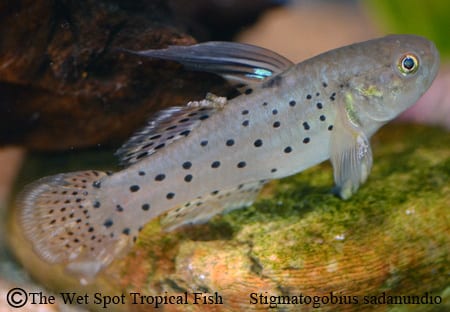Don’t Go(by) Chasing Waterfalls
Don’t Go(by) Chasing Waterfalls
Inspired by the passion disseminated by LA County Natural History Museum Curator of Ichthyology, Chris Thacker, in her interview on the podcast Ologies, this week gobies are on the mind. An ideal family for phylogenetic research, gobies belong to a monophyletic group (from a single common ancestor not shared with any other group) containing over 2,000 species in more than 200 genera that span nearly all aquatic habitats on earth! From mountain streams to coral reefs, gobies are unique for their diverse habitat ranges and the coinciding morphological characteristics and spawning behaviors. Due to highly functional kidneys and grippy, modified pelvic discs, many goby species have the capability to traverse barriers (as extreme as climbing waterfalls!) between salt and freshwater habitats. Of course, we are partial to species with the ability to thrive in freshwater, and have found no end of joy in observing these undeniably special scooters in our tropical aquaria. A few of our favorites include Stiphodon semoni, Stiphodon ornatus, and Stigmatogobius sadanundio.
Scientific NameStiphodon semoni
Common NameBlue Cobalt Gody
Temperature / pH72 to 82°F / 6.5 to 7.5 pH
Native LocationIndonesia
Preferred DietAlgae, biofilm
Found in coastal streams of tropical, volcanic islands in Indonesia, S. semoni are some of the few who make it into the VIF (very important fish) ranges of habitat lying above waterfalls for much of their adult lives. Reaching about 2 inches in length, these long-bodied, bottom-dwellers have beautiful lateral striping of cobalt blue and black. Aptly known as “Blue Cobalt Gobies”, they are relatively easy to keep in aquaria. Tanks must be equipped with tight fitting lids, and some combination of powerheads, filtration systems, and airstones to keep water flowing and well oxygenated. Substrate should be soft with many scattered, variably-sized, and water-worn rocks and pebbles. Additional furnishings can include items like aged wood and caves to form distinct territories. When kept in conspecific groups, males become slightly territorial, and must be provided ample space. To avoid aggression, groups should be comprised of a single male and 2 or more females. Generally peaceful by nature, they can be kept in well-chosen community tanks with small, peaceful stream-dwellers like danios, livebearers, various characids, and caridina shrimp. Stiphodon spp. are unique for their extrusible mouthparts and teeth. Using their pelvic fins for leverage, they scrape algae and biofilm from substrate with their regenerative teeth. Mature aquarium algae makes up the bulk of their diets, and including open sponge filters for accumulation of biofilm helps provide a secondary food source. Their diets can be padded with infrequent offerings of live and frozen meaty offerings, but they are not adapted to consuming these foods on a regular basis.
Scientific NameStiphodon ornatus
Common NameOrnate Rainbow Goby
Temperature / pH72 to 82°F / 6.5 to 7.5 pH
Native LocationSumatra/Indonesia
Preferred DietAlgae, biofilm
Known only in West Sumatra and Indonesia, S. ornatus are another goby found in coastal streams and habitats lying above waterfalls or cataracts. Reaching nearly 3 inches in length, these “Ornate Rainbow Gobies” are shiny silver with dark patterning along their bodies, and red/orange fins with dark rays. During courtship, males are truly spectacular, their bodies turning black with masks of neon blue. Another Stiphodon spp., these gobies should be kept following the same guidelines as outlined for the “Blue Cobalts” with regards to tank setup, compatibility, diet, and water chemistry. Remember that tight lid! You may fondly glimpse these guys using their pelvic discs to climb the glass, and it would be a shame if this useful adaptation in the wild led to their demise in captivity!
Scientific NameStigmatogobius sadanundio
Common NameKnight Goby
Temperature / pH68 to 78°F / 7.0 to 8.5 pH
Native LocationSoutheast Asia
Preferred DietSmall invertebrates
A more widely distributed species, S. sadanundio is found all over southeastern Asia. These “Knight Gobies” are a bit more robust in size reaching about 3.5 inches in length. With tan bodies, dark polka-dots, and yellow fins with blue accents, they look noble indeed, and are fun to watch as they form loose aggregations near the front of the tank. Inhabiting estuaries with both fresh and brackish waters, aquaria are best kept with ¼ marine strength salt component. Otherwise, tanks should be equipped with, once again, tight fitting lids!, and plenty of nooks, crannies, and caves formed from rockwork or wooden furnishings. They do best in dim-lighting, and do not require the presence of plants, though hardy plants that can survive in these conditions are appreciated for the cover they provide. Hardy and slightly aggressive, they are not ideal for most community tank setups, and are liable to eat any moving creature that fits in their mouths, or nip at slow-moving species with long fins. Optimal tank mates include hard-water or brackish species like archerfish, chromides, and rainbowfish. Predominantly micro-predators by nature, captive diets should be comprised heavily of live and frozen fare like daphnia or bloodworm, with some vegetal supplementation. They will also browse green algae off tank surfaces.
Temptation to spend vast amounts of time detailing the rich and fascinating variation found in the family Gobiidae aside, we have so many other purely freshwater fish to discuss! Be encouraged to listen to the charming, and fun-fact jam-packed Ologies interview with goby expert Chris Thacker to learn more. A favorite stand out tidbit: some gobies form mutualistic relationships with shrimp cohorts who build burrows, and the gobies defend them against predators in return. The gobies and their shrimp partners have their own special communication systems using tactile and water flow cues to make sure each is present and doing their part. Enter the enthralling world of gobies, and check out the amazing specimens we have to offer your aquaria today!


